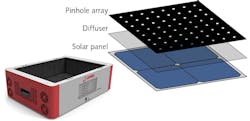FluxGage uses solar panels - not integrating spheres - to measure LED luminaires
Flux and color of LED luminaires are typically measured using an integrating sphere. Unfortunately, the sphere must be recalibrated frequently and self-absorption calibration is needed to account for the absorption by the LED device itself, not to mention that the sphere must be at least three times the size of the fixture to make an accurate measurement. But an alternative approach from Ophir-Spiricon (Logan, UT), a MKS Instruments company, requires only one calibration and can accommodate LED luminaires the same size as the measuring instrument itself.
Smaller, lighter, and less expensive than a comparable integrating sphere, FluxGage uses an array of photovoltaic absorbers, with each absorber consisting of photovoltaic cells sandwiched under a sheet diffuser covered with a black-ink-coated dense array of pinholes to better distribute the collected light and minimize reflections, making it insensitive to size and beam angle. A fiber-optic sensor delivers light to a spectrometer inside the system and a fast photodiode measures flicker. FluxGage measures total flux to an uncertainty of 6% and color parameters, including correlated color temperature (CCT), color rendering index (CRI), and chromaticity. Experimental measurements from an integrating sphere vs. FluxGage for LED luminaires with total flux values from 1000 to 30,000 lumens and CCT values between 2700 and 5700 K saw differences of only 1% in CCT and 1.5% in total flux. Reference: www.ophiropt.com/led/technology.

Gail Overton | Senior Editor (2004-2020)
Gail has more than 30 years of engineering, marketing, product management, and editorial experience in the photonics and optical communications industry. Before joining the staff at Laser Focus World in 2004, she held many product management and product marketing roles in the fiber-optics industry, most notably at Hughes (El Segundo, CA), GTE Labs (Waltham, MA), Corning (Corning, NY), Photon Kinetics (Beaverton, OR), and Newport Corporation (Irvine, CA). During her marketing career, Gail published articles in WDM Solutions and Sensors magazine and traveled internationally to conduct product and sales training. Gail received her BS degree in physics, with an emphasis in optics, from San Diego State University in San Diego, CA in May 1986.
